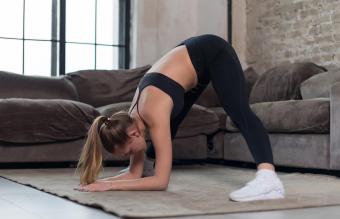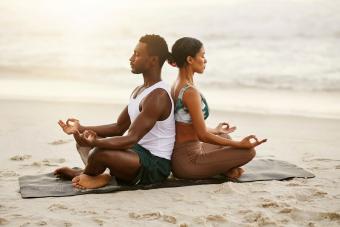
Using proper stretching techniques are essential for maintaining flexibility and avoiding injury. This article outlines the importance of stretching and describes proper stretching techniques.
The Importance of Stretching
Many people skip stretching as a regular part of their fitness routine. The reasons cited are numerous - ranging from lack of time to the widespread belief that stretching really doesn't forward one's fitness goals, anyway. The latter couldn't be further from the truth.
Muscle flexibility is one of the five components of physical fitness along with muscle strength, muscle endurance, cardiovascular conditioning and body composition.
At minimum, it is important to stretch following a workout and many trainers also recommend stretching prior to exercise, as well. Stretching is important because it improves your flexibility. Flexibility plays a key role in keeping your joints healthy and protected and reducing the chance of injury - especially to muscles, tendons and ligaments.
Flexibility later in life also becomes a quality of life issue. You tend to lose muscle and tendon flexibility as you age, which can lead to a whole host of aches, pains and injuries. Making stretching a regular part of every workout can you to avoid or prevent lack of flexibility as you age.
Proper Stretching Techniques
Without the use of proper stretching techniques, you can increase your chance of injury or, at the very least, render the stretching exercises you do ineffectual. In order to learn to stretch properly, it may be advantageous to schedule an appointment with a personal trainer, take a class that shows how to stretch, or view a video that demonstrates good form and safe stretching habits. In the absence of those opportunities, keep the following in mind when you stretch.
- If stretching prior to exercise, never stretch cold muscles. Always warm up gently with a few moments of light movement before stretching. Stretching cold muscles can lead to injury, strain and muscle pulls.
- Always stretch after exercise. Prior to stretching, take about five minutes to cool down the intensity of your workout. Lack of proper cool-down before stretching can cause blood to pool in your muscles and extremities.
- Always move into a stretch slowly. Moving to rapidly or jerking can cause a muscle strain or pull.
- Don't move to a point of pain. Instead, move into the stretch only to the point that you can feel the muscles stretching. If it hurts, take a deep breath and back off a degree until the pain disappears.
- Don't forget to breathe when you are stretching. To breathe properly during a stretch, take a deep breath prior to the stretch. As you move into the stretch, exhale until you have reached the full stretch. Breathe in and out slowly as you hold the stretch.
- Always hold the stretch at the point of tension. Don't bounce the stretch. Bouncing can lead to injury. All stretching motion should be fluid and controlled.
- If you'd like to deepen the stretch, you can increase your flexibility. There is a trick to it, however. In order to do this, you want to trigger something called your golgi tendon reflex. In order to do this, after holding your initial stretch for a few moments, let off of the stretch slightly and then slowly move into a deeper stretch in a controlled manner. If it hurts, stop. This can be done in virtually any stretch.
- In order for stretches to be effective, you will need to hold them much longer than you think is necessary. A slow count of 20 is recommended to maximize the benefits of each stretch.
- Never perform a stretch that causes you flex forward from your trunk without support. Unsupported forward flexion can put a great deal of stress on your lower vertebrae, possibly leading to lower back injury.
- Stretch each major muscle group. Some stretches for each are recommended below.
Stretching Exercises
- Neck - Bring your chin to your chest. Gently roll your head forward across your chest, bringing your right ear to your right shoulder. Slowly roll your head across your chest in the other direction, bringing your left ear to your left shoulder. Hold each position for a slow count of 20.
- Shoulders and upper back - Perform slow shoulder shrugs, raising your shoulders to your ears and returning them to normal. Next, rotate your shoulders in a circle forward five times. Reverse motion and repeat five times.
- Biceps - Stand in a doorway using the sides of the door to support your upper arms on each side. Slowly and gently lean forward into the doorway until you feel a stretch. Hold for slow count of 20 and release.
- Triceps - Hold your right arm out in front of you. Place the palm of our left hand above the elbow of your right arm and slowly bring your right arm across the front of your body until you feel a stretch. Repeat on the other side.
- Quadriceps - Lie on the floor on your side with your right side facing up. Bend your right leg, grasping your shin above your ankle on the right side to deepen the stretch. Hold for a slow count of 20. Switch sides and repeat.
- Hamstrings - Sit on the floor with your right leg extended forward and your knee bent on the floor so that the bottom of your left foot is facing in towards your right leg. Slowly bend forward from your trunk and reach for your toes with your right hand until you feel a stretch in your hamstring. Do the same on the other leg.
- Calves - Standing on the right foot, place the ball of your left foot against the edge of a step and slowly press downward with your heel until you feel a stretch in your calf. Repeat on the other side.
Explore these stretching techniques to improve your workout and prevent injury.







